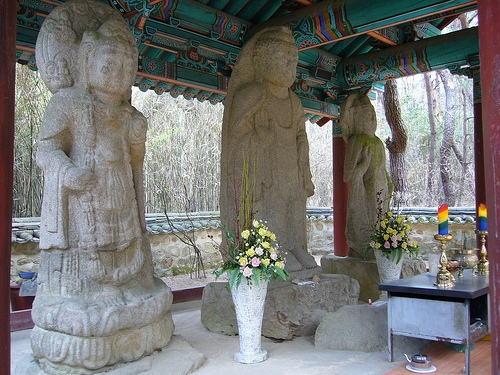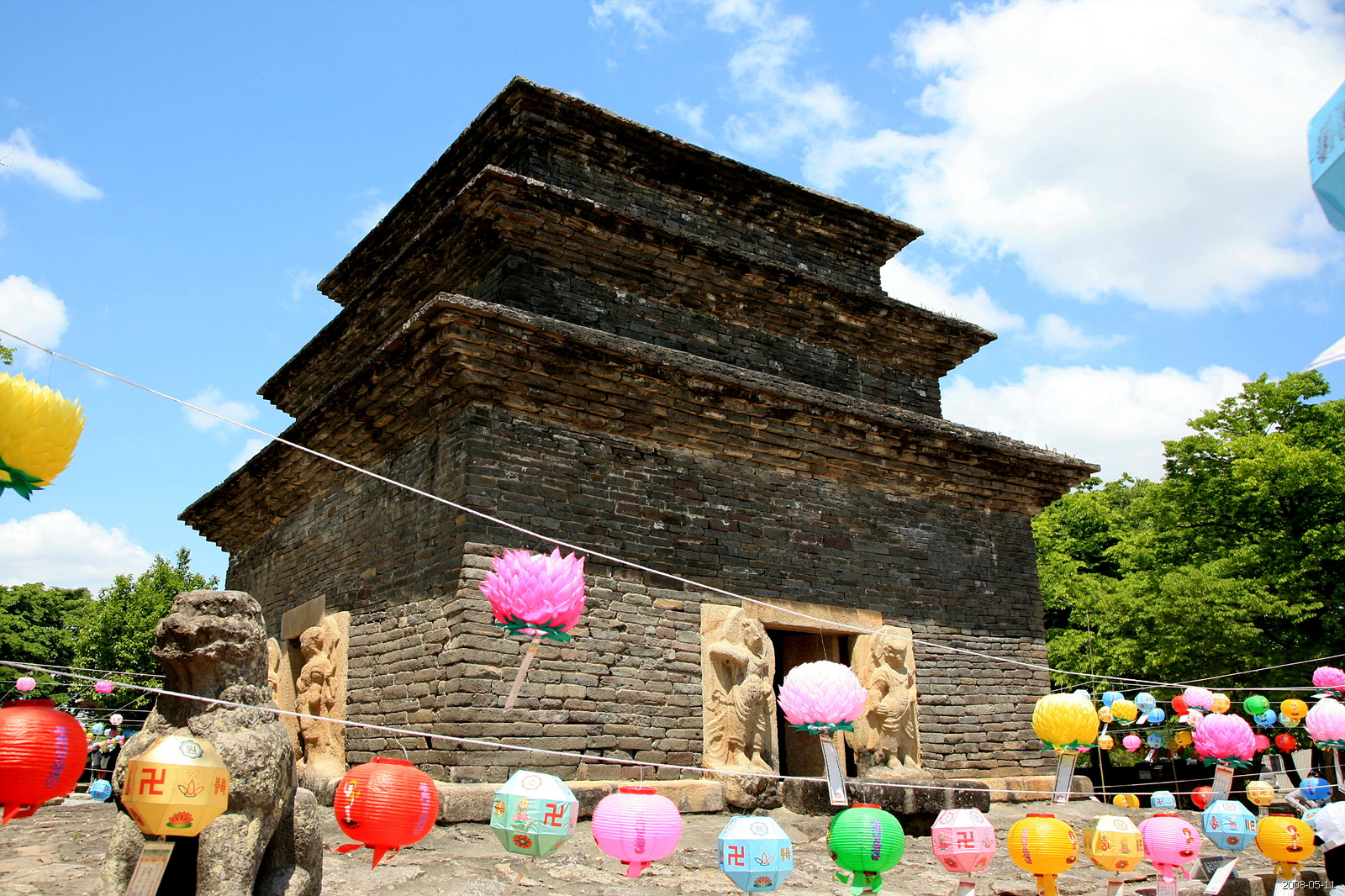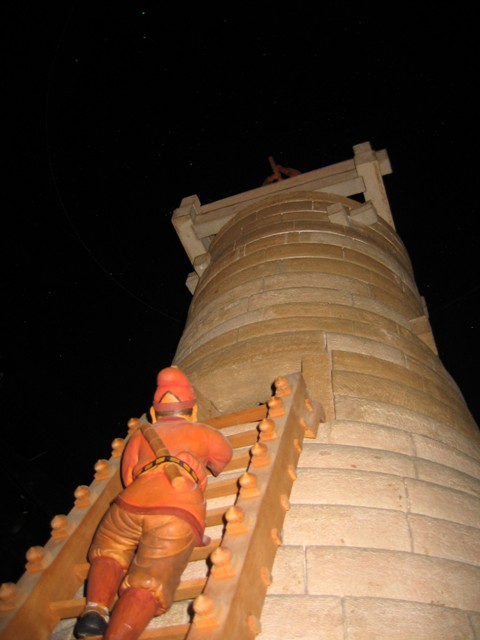|
Gyeongju Historic Areas
The Gyeongju Historic Areas of South Korea were designated as a World Heritage Site by UNESCO in 2000. The protected areas encompass the ruins of temples and palaces, outdoor pagodas and statuary, and other cultural artifacts left by the Silla Kingdom. The historic areas are sometimes known as one of the largest outdoor museums in the world. Organization of the areas Mount Namsan Belt The Mount Namsan belt is anchored by Mount Namsan, a mountain that was held sacred by the Silla people. Both Buddhist artifacts and artifacts related to Shamanism that predate the introduction of Buddhism to Korea have been found at this site. Buddhist artifacts include the ruins of 122 temples, 53 stone statues, 64 stone pagodas, and sixteen stone lanterns. Other notable sites include the Namsan Mountain Fortress (built in 591 CE), the Poseokjeong Pavilion site (famous for its abalone-shaped watercourse), and the Seochulji Pond. Mount Namsan is famous for the various Buddhist images carved ... [...More Info...] [...Related Items...] OR: [Wikipedia] [Google] [Baidu] |
Tumulus
A tumulus (plural tumuli) is a mound of earth and stones raised over a grave or graves. Tumuli are also known as barrows, burial mounds or ''kurgans'', and may be found throughout much of the world. A cairn, which is a mound of stones built for various purposes, may also originally have been a tumulus. Tumuli are often categorised according to their external apparent shape. In this respect, a long barrow is a long tumulus, usually constructed on top of several burials, such as passage graves. A round barrow is a round tumulus, also commonly constructed on top of burials. The internal structure and architecture of both long and round barrows has a broad range; the categorization only refers to the external apparent shape. The method of may involve a dolmen, a cist, a mortuary enclosure, a mortuary house, or a chamber tomb. Examples of barrows include Duggleby Howe and Maeshowe. Etymology The word ''tumulus'' is Latin for 'mound' or 'small hill', which is derived from th ... [...More Info...] [...Related Items...] OR: [Wikipedia] [Google] [Baidu] |
Gyerim
The Gyerim is a small woodland in Gyeongju National Park, Gyeongju, South Korea. The name literally means "rooster forest." The grove lies near the old site of the Silla kingdom palace in central Gyeongju. Nearby landmarks include the Banwolseong fortress, Cheomseongdae, the Gyeongju National Museum, and the Royal Tombs Complex.Gyeongju Gyerim at Doosan Encyclopedia History The original name of Gyerim was Sirim (시림, 始林). However, according to the Samguk Sagi, a 12th-century Korean history, Sirim was the site where the child Kim Alji, founder of the Kim (Korean surname)#Gyeongju, Gyeongju Kim clan, was discovered. Found in a golden box accompanied by a rooster, he was adopted by the royal family. His descendants became the later kings of Silla and the forest where he was found was renamed ''Gyerim'', " ...[...More Info...] [...Related Items...] OR: [Wikipedia] [Google] [Baidu] |
Buildings And Structures In Gyeongju
A building, or edifice, is an enclosed structure with a roof and walls standing more or less permanently in one place, such as a house or factory (although there's also portable buildings). Buildings come in a variety of sizes, shapes, and functions, and have been adapted throughout history for a wide number of factors, from building materials available, to weather conditions, land prices, ground conditions, specific uses, prestige, and aesthetic reasons. To better understand the term ''building'' compare the list of nonbuilding structures. Buildings serve several societal needs – primarily as shelter from weather, security, living space, privacy, to store belongings, and to comfortably live and work. A building as a shelter represents a physical division of the human habitat (a place of comfort and safety) and the ''outside'' (a place that at times may be harsh and harmful). Ever since the first cave paintings, buildings have also become objects or canvasses of much artis ... [...More Info...] [...Related Items...] OR: [Wikipedia] [Google] [Baidu] |
Buddhist Archaeological Sites In Korea
Buddhism ( , ), also known as Buddha Dharma and Dharmavinaya (), is an Indian religion or philosophical tradition based on teachings attributed to the Buddha. It originated in northern India as a -movement in the 5th century BCE, and gradually spread throughout much of Asia via the Silk Road. It is the world's fourth-largest religion, with over 520 million followers (Buddhists) who comprise seven percent of the global population. The Buddha taught the Middle Way, a path of spiritual development that avoids both extreme asceticism and hedonism. It aims at liberation from clinging and craving to things which are impermanent (), incapable of satisfying ('), and without a lasting essence (), ending the cycle of death and rebirth (). A summary of this path is expressed in the Noble Eightfold Path, a training of the mind with observance of Buddhist ethics and meditation. Other widely observed practices include: monasticism; "taking refuge" in the Buddha, the , and the ; and ... [...More Info...] [...Related Items...] OR: [Wikipedia] [Google] [Baidu] |
Archaeological Sites In South Korea
Archaeology or archeology is the scientific study of human activity through the recovery and analysis of material culture. The archaeological record consists of artifacts, architecture, biofacts or ecofacts, sites, and cultural landscapes. Archaeology can be considered both a social science and a branch of the humanities. It is usually considered an independent academic discipline, but may also be classified as part of anthropology (in North America – the four-field approach), history or geography. Archaeologists study human prehistory and history, from the development of the first stone tools at Lomekwi in East Africa 3.3 million years ago up until recent decades. Archaeology is distinct from palaeontology, which is the study of fossil remains. Archaeology is particularly important for learning about prehistoric societies, for which, by definition, there are no written records. Prehistory includes over 99% of the human past, from the Paleolithic until the adv ... [...More Info...] [...Related Items...] OR: [Wikipedia] [Google] [Baidu] |
World Heritage Sites In South Korea
The United Nations Educational, Scientific and Cultural Organization (UNESCO) World Heritage Sites are places of importance to cultural or natural heritage as described in the UNESCO World Heritage Convention, established in 1972. Cultural heritage consists of monuments (such as architectural works, monumental sculptures, or inscriptions), groups of buildings, and sites (including archaeological sites). Natural features (consisting of physical and biological formations), geological and physiographical formations (including habitats of threatened species of animals and plants), and natural sites which are important from the point of view of science, conservation or natural beauty, are defined as natural heritage. The Republic of Korea (South Korea) accepted the convention on 14 September 1988, making its historical sites eligible for inclusion on the list. , there are 15 World Heritage Sites in South Korea, and a further 13 on the tentative list. The first three sites of South Ko ... [...More Info...] [...Related Items...] OR: [Wikipedia] [Google] [Baidu] |
Tourism In Gyeongju
Tourism in Gyeongju is a major industry and defining feature of Gyeongju, South Korea. Gyeongju is a major cultural site and tourist destination for South Koreans and foreigners with about 8 to 9 million visitors annually. A great deal of this is due to the city's status as a center of Silla heritage, derived from its former role as the capital of that ancient kingdom. Silla remains Many Silla sites are included in Gyeongju National Park. In addition, the Gyeongju National Museum hosts many artifacts from the Silla kingdom which have been excavated from sites within the city and surrounding areas, including several royal crowns and other national treasures. Some of Gyeongju's most famous sites relate to the Silla government's patronage of Buddhism. The grotto of Seokguram and the temple of Bulguksa were the first Korean sites to be included on the UNESCO World Heritage List, in 1995. In addition, the ruins of the old Hwangnyongsa temple, said to have been Korean's largest, are ... [...More Info...] [...Related Items...] OR: [Wikipedia] [Google] [Baidu] |
Gyeongju National Park
Gyeongju National Park ( ko, 경주국립공원, 慶州國立公園) is located in the province of Gyeongsangbuk-do, South Korea, and is the country's only historical national park. It was first designated a national park in 1968. The park covers many of the principal Silla historical sites in Gyeongju City. It is divided into several non-contiguous sections: Gumisan and Danseoksan sections to the west of the city center; Hwarang, Seo-ak, Sogeumgang, and Namsan sections in the heart of Gyeongju; Tohamsan section to the east, and Daebon section on the coast of the Sea of Japan The Sea of Japan is the marginal sea between the Japanese archipelago, Sakhalin, the Korean Peninsula, and the mainland of the Russian Far East. The Japanese archipelago separates the sea from the Pacific Ocean. Like the Mediterranean Sea, it h ... (East Sea). References External linksThe park's page on Korea National Park Service's website Parks in North Gyeongsang Province National parks of ... [...More Info...] [...Related Items...] OR: [Wikipedia] [Google] [Baidu] |
Bunhwangsa
Bunhwangsa ("Fragrant Imperial Temple") is a temple complex from the Old Silla era of Korea. It is located in Gyeongju. The temple is recorded to have been built in 634 under the auspices of Queen Seondeok. Today the temple is still used by a small group of worshipers but in its heyday, the temple covered several acres and was one of the four main temples of the Silla Kingdom used by the state to ask the Buddha to bless the kingdom. The ruins of Hwangnyongsa Temple lay nearby. It is part of the UNESCO world heritage site Gyeongju Historic Areas. National Treasure No. 30 A notable ruin at the temple is the Bunhwangsa Pagoda (Kr. Bunhwangsa Seoktap, literally "Stone Pagoda of Bunhwangsa"), the oldest dated pagoda from the Silla Kingdom. The pagoda is National Treasure of Korea No. 30 and was designated by the South Korean government on December 20, 1962. The pagoda is based on prototypes from the Tang Dynasty in China. However, unlike Tang pagodas which were made from brick, S ... [...More Info...] [...Related Items...] OR: [Wikipedia] [Google] [Baidu] |
Hwangnyongsa
Hwangnyongsa, or Hwangnyong Temple (also spelled Hwangryongsa) was a Buddhist temple in the city of Gyeongju, South Korea. Completed in the 7th century, the enormous 9-story structure was built entirely with wood with interlocking design with no iron nails. It had a standing total height of 68 m (223 ft) or 80 m (262 ft), making it one of the tallest structures in East Asia at the time of its construction. Only the massive foundation stones of the temple remain in current times. Hwangryongsa was the center of state-sponsored Buddhism during the Silla and Unified Silla eras which were cultural beacons of Buddhism during its time. Its name means "Emperor/Imperial Dragon Temple." Archaeological excavations and other scientific studies of the temple began in April 1976 (OCPRI 1984) and continue today. History Hwangnyongsa was built during the Silla period, under the patronage of the Silla royal family, on a plain encircled by mountains near the royal palace compound o ... [...More Info...] [...Related Items...] OR: [Wikipedia] [Google] [Baidu] |
Heavenly Horse Tomb
Cheonmachong, formerly Tomb No.155 in South Korea, is a tumulus located in Gyeongju, South Korea. The name "Cheonmachong" means Sky horse tomb. This tomb was built in the style of Silla. Excavation of the tomb began on April 16, 1973 and is believed to date probably from the fifth century but perhaps from the sixth century CE. The tomb was for an unknown king of the Silla Kingdom.Barbara Ann Kipfer''Encyclopedic Dictionary of Archaeology'', p.232/ref> The tomb, in typical Silla style, is a wood-lined chamber running east to west and is covered in a mound of boulders and earth. Sarah Milledge Nelson''The Archaeology of Korea'', p.250/ref> This kind of tomb is said to follow the pattern of a Scytho-Iranian tomb in Pazyryk, Russia.Richard Rutt, Keith L. Pratt''Korea: A Historical and Cultural Dictionary'', p.165/ref> The tomb is 47 metres in diameter, 157 metres in circumference, and 12.7 metres in height. The chamber of the tomb contained a lacquered wooden coffin which had b ... [...More Info...] [...Related Items...] OR: [Wikipedia] [Google] [Baidu] |
Cheomseongdae
Cheomseongdae ( ko, 첨성대; Hanja: , ) is an astronomical observatory in Gyeongju, South Korea. Cheomseongdae is the oldest surviving astronomical observatory in Asia, and possibly even the world. It was constructed in the 7th century in the kingdom of Silla, whose capital was Seorabeol, or present-day Gyeongju (Hangul: ). Cheomseongdae was designated as the country's 31st national treasure on December 20, 1962. Modeled on Baekje's Jeomseongdae, which now exists only in historical records, the Cheomseongdae influenced the construction of the Japanese observatory in 675, and Duke Zhou's observatory in China in 723. Structure Cheomseongdae stands 9.17 meters high and consists of three parts: a stylobate, or base upon which a column is constructed, a curved cylindrical body, and a square top. Midway up the body stands a square window and entrance to the inside of the structure. When viewed from above, Cheomseongdae resembles the Korean Hanja character (Hangul: ), meaning "we ... [...More Info...] [...Related Items...] OR: [Wikipedia] [Google] [Baidu] |



.jpg)



